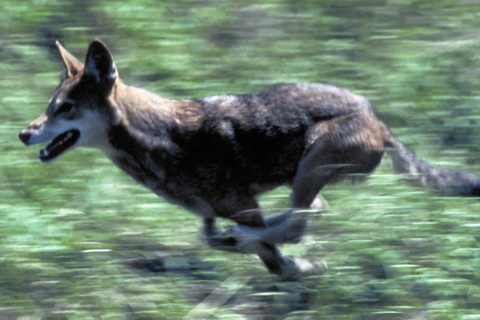Red Wolf
From Wikipedia, the free encyclopedia
[Photo] Red wolf. Source: U.S. Fish & Wildlife Service. Date: February 12, 2002. Photographer: Curtis Carley
The Red Wolf (Canis rufus) is a mammal of the order carnivora. It is one of the rarest canid species and is one of the most endangered animals in the world. It once roamed throughout the Southeastern United States. Aggressive predator control programs, hunting and agriculturalization have combined to bring the red wolf near to extinction, because it was thought to be a threat to livestock.
It is thought that its original distribution included much of eastern North America, where Red Wolves were found from Pennsylvania in the east, Florida in the south, and Texas in the south-east. On the basis of further study, its historic range is now thought to have extended further north into the northeastern USA and extreme eastern Canada. There are thought to be only 249 red wolves remaining in the world, and 200 of those reside in captivity. For decades, the Red Wolf has been indistinguishable genetically from either the Gray Wolf or the Coyote. The Red Wolf breeds with both species and may again be in peril as contact with other species in the wild resumes.
Traditionally, three subspecies of Red Wolf are recognized. Two of these subspecies are extinct. Canis rufus floridanus has been extinct since 1930 and Canis rufus gregoryi was declared extinct in the wild by 1970. Canis rufus rufus, the other surviving subspecies, was extirpated in 1980, although that status was changed to "critical" when 100 wolves were reintroduced in North Carolina.
In 1987 approximately 100 were reintroduced into the wild as the first island propagation project in the Alligator River National Wildlife Refuge off the coast of North Carolina. In 1989 the second island propagation project initiated with release of a population on Horn Island of the Mississippi coast. This population was moved in 1998 because of a likelihood of encounters with humans. The third island propagation project introduced a population on St. Vincent Island, Florida offshore between Cape San Blas and Apalachicola, Florida in 1990 and in 1997 the fourth island propagation program introduced a population to Cape St. George Island, Florida south of Apalachicola, Florida. In 1991 two pairs were reintroduced into the Great Smoky Mountains National Park, where the last known wolf was killed in 1905. Despite some early success, the wolves were relocated to North Carolina in 1998, ending the effort to reintroduce the species to the Park. There are 170 in captivity. Historical habitats included forests, swamps and coastal prairies, where it was an apex predator.
Habits and social structure
Red Wolves are shy and wary creatures. They prefer to hunt alone or in small family groups; pack sizes are smaller than those of their grey cousins, consisting often of one adult pair and their offspring.
As in other canids pair-bonding is strong and Red Wolves mate for life. They mate yearly and two or three pups are usually born in the spring. Both parents help raise the offspring who are mature enough to leave behind parental support at six months of age.
Their diet consists of small animals, including rabbits, raccoons and rodents. They occasionally bring down deer with the help of other wolves and they supplement their diet with insects and berries.
Taxonomy
The taxonomic status of the Red Wolf has long been controversial: the original view, based on morphologic research by Nowak is that the red wolf is a distinct species. More recent genetic research and cross-breeding potential indicates that the Red Wolf is simply a recent hybrid between the Grey Wolf and the Coyote. Genetic comparison is considered by modern biologists to be superior to morphological comparison.
On the whole, genetic evidence does not support the view that there has been a distinct Red Wolf population, but much confusion and not a little controversy remains. There seems little doubt that there has been considerable hybridisation between Red Wolves, Grey Wolves and Coyotes, and that in recent years the Red Wolf has declined and been replaced over most of its range by Coyotes. The Red Wolf and the Coyote have not reached a sufficient state of reproductive isolation to be considered biological species - that is, each one forms a distinct evolutionary lineage. Over time the Red Wolf lineage would probably be absorbed back into those of the other two species, as it still can hybridize with both.
In 1999, Brad White of McMaster University and Paul Wilson of Trent University found evidence suggesting that the wolves of south-eastern Canada (previously assumed to be Grey Wolves) were in fact Red Wolves, a view which has since found support in fossil, genetic and morphological evidence. The Eastern Canadian Wolf, as this population has been named, ranges from Minnesota to Quebec.
The taxonomic debate is not simply a matter of accurate classification. Although the actual patterns of evolution are complex and subtle, classification schemes usually rely on relatively simple, hard-edged divisions, such as the concept of species. It remains a crucial concept, as many environmental policy decisions revolve around the species concept and the result of this debate determines the expenditure of money by the EPA to preserve this potential species, thus removing that money from the efforts to preserve other endangered animals. In law, a distinct "species" is much better protected than a "subspecies". The Grey Wolf-Red Wolf-Coyote dilemma is a striking example of the influence of political rhetoric and fiduciary decisions on the outcomes of scientific research and evaluation.
http://en.wikipedia.org/wiki/Red_Wolf
| The text in this page is based on the copyrighted Wikipedia article shown in above URL. It is used under the GNU Free Documentation License. You may redistribute it, verbatim or modified, providing that you comply with the terms of the GFDL. |
|

